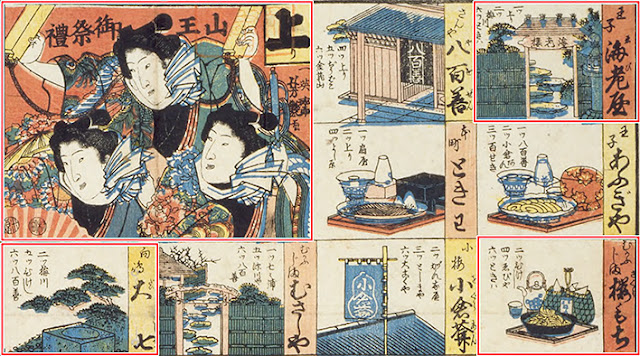. Ukiyo-e 浮世絵 "pictures of the floating world" .
::::::::::::::::::::::::::::::::::::::::::::::::::::::::::::::::::::::::::::::::::::::::::::::::::::::::::::::::::::::::::::::::::::::::::::::::::::::::::::::::::::::::::::::::::::
ukiyo-e (ukiyoe) 浮世絵 "pictures of the floating world"
hanga 版画 woodblock prints
Many aspects of life in the Edo period are depicted in Ukiyo-E and
many more museum and gallery collections are coming online.
. Join the Ukiyo-E friends on facebook ! .

..............................................................................................................................................
. Ukiyo-e 浮世絵 "pictures of the floating world" .
- Introduction -
::::::::::::::::::::::::::::::::::::::::::::::::::::::::::::::::::::::::::::::::::::::::::::::::::::::::::::::::::::::::::::::::::::::::::::::::::::::::::::::::::::::::::::::::::::
Adachi Institute of Woodcut Prints 浮世絵のアダチ版画 - Hanga Database

With many details and explanations of each print.
- source : adachi-hanga.com/ukiyo-e-
Our studio and showroom are located in Tokyo
- source English : adachi-hanga.com/en_ukiyo-e -
::::::::::::::::::::::::::::::::::::::::::::::::::::::::::::::::::::::::::::::::::::::::::::::::::::::::::::::::::::::::::::::::::::::::::::::::::::::::::::::::::::::::::::::::::::
Edo no Meibutsu 江戸の名物、名店

英斎芳艶 : 海老屋林之助
Nishiki E 錦絵 - National Diet Library
- source : ndl.go.jp/landmarks/column-
Ukiyoe Caricatures 錦絵の風刺画, 1842-1905
Institut für Ostasienwissenschaften der Universität Wien
- source : ukiyoe.univie.ac ... -
::::::::::::::::::::::::::::::::::::::::::::::::::::::::::::::::::::::::::::::::::::::::::::::::::::::::::::::::::::::::::::::::::::::::::::::::::::::::::::::::::::::::::::::::::::
Freer Gallery of Art - Database
The World of the Japanese Illustrated Book
The Pulverer Collection, acquired in its entirety by the Freer Gallery of Art in 2007, includes numerous rare and pristine examples of Japanese illustrated books produced in the Edo period and beyond.

Shokunin burui 職人部類 and many more
1050 Independence Ave SW, Washington, DC 20560, United States
- source : pulverer.si.edu -
::::::::::::::::::::::::::::::::::::::::::::::::::::::::::::::::::::::::::::::::::::::::::::::::::::::::::::::::::::::::::::::::::::::::::::::::::::::::::::::::::::::::::::::::::::

Aesthetic Strategies of The Floating World: Mitate, Yatsushi, and Fūryū in Early Modern Japanese Popular Culture
Alfred Haft (Sainsbury Institute for the Study of Japanese Arts and Cultures)
Japan’s classical tradition underpinned almost every area of cultural production throughout the early modern or Edo period (1615–1868). This book offers the first in-depth account of three aesthetic strategies—unexpected juxtaposition (mitate), casual adaptation (yatsushi) and modern standards of style (fūryū)—that shaped the way Edo popular culture and particularly the Floating World absorbed and responded to this force of cultural authority. Combining visual, documentary and literary evidence, Alfred Haft here explores why the three strategies were central to the life of the Floating World, how they expanded the conceptual range of the popular woodblock print (ukiyo-e), and what they reveal about the role of humor in the Floating World’s relationship with established society. Through a critical analysis of prints by major artists such as Harunobu, Koryūsai, Utamaro, Eishi and Hiroshige, Aesthetic Strategies of the Floating World shows how the strategies made ukiyo-e not merely the by-product of a demimonde, but an agent in the social and cultural politics of their time.
- source : brill.com/aesthetic-strategies... -
::::::::::::::::::::::::::::::::::::::::::::::::::::::::::::::::::::::::::::::::::::::::::::::::::::::::::::::::::::::::::::::::::::::::::::::::::::::::::::::::::::::::::::::::::::
Hiroshige - Thirty-six enjoyments of Edo / Thirty-six Views of the Pride of Edo
Edo jiman sanjūrokkyo 江戸 自慢 三十六興
- reference -
- source : Hiroshige Portal -
::::::::::::::::::::::::::::::::::::::::::::::::::::::::::::::::::::::::::::::::::::::::::::::::::::::::::::::::::::::::::::::::::::::::::::::::::::::::::::::::::::::::::::::::::::
Kamigata Ukiyo-e Museum 上方浮世絵館

displaying paintings and prints of Ukiyoe from Edo period
Namba, Chuo-ku, Osaka City, Osaka Prefecture
- source : kamigata.jp/kmgt/ -
::::::::::::::::::::::::::::::::::::::::::::::::::::::::::::::::::::::::::::::::::::::::::::::::::::::::::::::::::::::::::::::::::::::::::::::::::::::::::::::::::::::::::::::::::::
Metropolitan Museum of Art

Art of the Pleasure Quarters and the Ukiyo-e Style
Woodblock Prints in the Ukiyo-e Style
1000 5th Ave, New York, NY 10028, United States
- source : metmuseum.org/toah -
..............................................................................................................................................
National Diet Library
The Landmarks of Edo in Color Woodblock Prints
- with various search functions
- source : ndl.go.jp/landmarks -
..............................................................................................................................................
"芝居と食べ物" and "江戸の美味探訪"
- source : kabuki-za.co.jp/syoku-
. Edo no Shokubunka 江戸の食文化 .
..............................................................................................................................................

浮世絵でみる! お化け図鑑 / 中右瑛 Nakau Ei
Something Wicked from Japan
in Japanese and English
- reference: amazon com -
..............................................................................................................................................
浮世絵・妖術使い名鑑 / 江戸妖怪大図鑑
『児雷也豪傑譚』では児雷也の恋人
大蛇丸(おろちまる)
児雷也と大蛇丸が巨大なガマ
白面金毛九尾の狐という化け物
滝夜刃(たきやしゃ)。平将門の遺児。
平太郎良門(たいらのたろうよしかど)。平将門の遺児
鬼童丸(きどうまる)
袴垂保輔(はかまだれ・やすすけ)
若菜姫(わかなひめ)
虎王丸(とらおうまる)
美妙水義高(しみず・よしたか)
天竺徳兵衛(てんじく・とくべえ)
綱手(つなで)。ナメクジの妖術使い
大蛇丸(おろちまる)
藤浪由縁之丞(ふじなみ・ゆかりのじょう)
蒙雲国師(もううんこくし)。蛟(みずち)
妙椿(みょうちん)
ネズミが妖術を使っている
- source : togetter.com -
..............................................................................................................................................
俳優見立夏商人 - by Kunisada
- reference : www.google.co.jp -
..............................................................................................................................................
Ukiyo zoshi daijiten" 浮世草子大事典
江戸時代の社会・風俗がわかる understanding Edo-period society and popular customs
..............................................................................................................................................
- further reference -
::::::::::::::::::::::::::::::::::::::::::::::::::::::::::::::::::::::::::::::::::::::::::::::::::::::::::::::::::::::::::::::::::::::::::::::::::::::::::::::::::::::::::::::::::::

- - - To join me on facebook, click the image !
. further reference on the facebook page .
:::::::::::::::::::::::::::::::::::::::::::::::::::::::::::::::::::::::::::::::::::::::::::::::::::::::::::::::::::::::::::::::::::::::::::::::::::::::::::::::::::::::::::::::::::::
. Edo bakufu 江戸幕府 The Edo Government .
. Famous Places and Powerspots of Edo 江戸の名所 .
. Doing Business in Edo - 商売 - Introduction .
[ . BACK to DARUMA MUSEUM TOP . ]
[ . BACK to WORLDKIGO . TOP . ]- - - - - ##ukiyoe #hanga #floatingworld #nishikie - - - -
::::::::::::::::::::::::::::::::::::::::::::::::::::::::::::::::::::::::::::::::::::::::::::::::::::::::::::::::::::::::::::::::::::::::::::::::::::::::::::::::::::::::::::::::::::





































